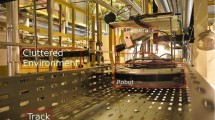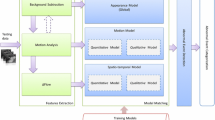Abstract
Cubic Higher-Order Local Auto-Correlation (CHLAC) is feature vector that simultaneously represent motion and shape. The system learns a sample set of “usual motion” to create a “usual subspace” with PCA. Feature vectors are then similarly extracted from unknown input data, and accurate detection of “unusual motion” is achieved by measuring the deviation from the usual subspace. Therefore, by defining unusual motion as “motion that is outside the usual motion,” this method can detect unusual motion without an actual model of unusual motion, which differs depending on the situation, and furthermore, is difficult to define. This paper reports on the fast CHLAC that we have developed, so that these capabilities of CHLAC can be put to practical use as an unusual motion detection system that operates in real time. This paper also demonstrated the effectiveness of this method through example tests, conducted using real images both indoors and outdoors.
Preview
Unable to display preview. Download preview PDF.
Similar content being viewed by others
References
Haritaoglu, I., Harwood, D., Davis, L.S.: W4: Who? When? Where? What? A real time system for detecting and tracking people. In: Proc. FG 1998, pp. 222–227 (1998)
Aoki, S., Onishi, M., Kojima, A., Fukunaga, K.: Learning and Recognizing Behavioral Patterns Using Position and Posture of Human. In: Proc. of IEEE Conference on Cybernetics and Intelligent Systems, December 2004, pp. 1299–1302 (2004)
Zelnik-Manor, L., Irani, M.: Event-Based Analysis of Video. In: Proc. CVPR 2001, vol. 2, pp. 123–130 (2001)
Zhong, H., Shi, J., Visontai, M.: Detecting Unusual Activity in Video. In: Proc. CVPR 2004, vol. 2, pp. 819–826 (2004)
Lucas, B., Kanade, T.: An Iterative Image Registration Technique with an Application to Stereo Vision. In: Proc. IJCAI 1981, April 1981, pp. 674–679 (1981)
Bobick, A.F., Davis, J.W.: The Recognition of Human Movement Using Temporal Templates. IEEE Trans. PAMI 23(3) (2001)
Kobayashi, T., Otsu, N.: Action and Simultaneous Multiple Persons Identification Using Cubic Higher-order Local Auto-Correlation. In: Proc. ICPR 2004 (2004)
Nanri, T., Otsu, N.: Unsupervised Abnormality Detection in Video Surveillance. In: Proc. MVA 2005, pp. 574–577 (2005)
Otsu, N., Kurita, T.: A new scheme for practical flexible and intelligent vision systems. In: Proceedings of IAPR Workshop on Computer Vision, pp. 431–435 (1988)
Author information
Authors and Affiliations
Editor information
Rights and permissions
Copyright information
© 2008 Springer-Verlag Berlin Heidelberg
About this paper
Cite this paper
Iwata, K., Satoh, Y., Kobayashi, T., Yoda, I., Otsu, N. (2008). Application of the Unusual Motion Detection Using CHLAC to the Video Surveillance. In: Ishikawa, M., Doya, K., Miyamoto, H., Yamakawa, T. (eds) Neural Information Processing. ICONIP 2007. Lecture Notes in Computer Science, vol 4985. Springer, Berlin, Heidelberg. https://doi.org/10.1007/978-3-540-69162-4_65
Download citation
DOI: https://doi.org/10.1007/978-3-540-69162-4_65
Publisher Name: Springer, Berlin, Heidelberg
Print ISBN: 978-3-540-69159-4
Online ISBN: 978-3-540-69162-4
eBook Packages: Computer ScienceComputer Science (R0)




